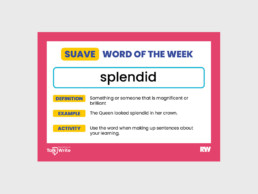Be Word Wise
The following blog is one of a series linked to the Talk:Write programme to improve children’s oratory and writing.
The series includes:
Be the Speaker: improve children’s confidence, clarity, correct use of English and skills of oratory as a speaker. Aim: to enable all children to speak clearly, confidently and articulately in Standard English when required, and thus to influence the accuracy and style of their written work. Read Blog
Be the Teacher: empower children to correct their own and other’s grammar and pronunciation in speech, or grammar, spelling and punctuation in writing. Aim: to enable all children to recognise their own and other’s mistakes in written work and to edit or correct appropriately. Read Blog
Be Word Wise: enrich children’s vocabulary with a wide range of suave words that they know, understand, can spell and can use correctly in appropriate contexts. Aim: to expand children’s vocabulary significantly, including the use of words that are normally found in the speech or writing of a child of that age.
The contents of these three blogs complement each other and support each other in empowering pupils to be mature and articulate speakers and writers.
It was very gratifying to see the following synopsis yesterday, when I was due to write this blog to complete a series in support of our new programme, Talk:Write. My start had been slower than slow – inspiration being obstructed by a rash of proof reading and editorials – and suddenly here it was!
An article in the Journal of Research on Educational Effectiveness, Volume 8, 2015, Issue 3 entitled Efficacy of Rich Vocabulary Instruction in Fourth-and Fifth-Grade Classrooms summarising research conducted by Vadasy, Sanders and Logan Herrera of the University of Washington.
The trio conducted a randomised trial to test the effects of pro-actively teaching ambitious and exciting vocabulary to over 6,000 fourth and fifth grade pupils, comparing the impact to a similar number of children learning in ‘business as usual’ settings. Not surprisingly, the overall understanding and absorption of the words by pupils in the pro-actively taught set supports the application of pro-active teaching.
Since 1997, I have actively promoted the pro-active teaching of ambitious vocabulary in both primary and secondary schools. From 2000 to the present day, I have written, modelled and presented CPD on the importance of talk and vocabulary in improving children’s prowess as speakers and writers.
Step 1
Pro-actively teach a suave word each week throughout the school year. To facilitate this, we publish a set of free suave word resources each week in our free resources section and on Twitter (another of my passions!) for busy teachers to use if they wish. Most of our suave words are single syllable, yet still ambitious when used correctly. This enables a whole school to focus on the same word each week, meaning siblings can share suave word homework with each other and their parents or guardians, and one assembly a week can celebrate the word and play one or two of the games across the school.
There should be one suave word homework evening a week in a school. It is usually launched at the beginning of the week with the head or another leader introducing the word to the whole Key Stage or school during the assembly. The word would be displayed, explained and exemplar uses shared with the children. The words are carefully chosen to be accessible and achievable to all years in the school, making the homework discussion with family members much more attainable.
An example of a single syllable word might be ‘thrill’ or ‘angst’ while an accessible double-syllable one might be ‘headlong’ which is quite easy to learn and spell because it combines two known short words. We do offer a suave word of the week and supporting activities free on the website, however this programme is totally flexible and teachers may choose different words that they feel are more appropriate for their class or school, and may adapt games and activities to suit their classes. We also offer a ‘Suave Word Plus’ resource for children around 7 to 12, which involves learning more complex words.
‘Playing games’ with the children through a range of suave word activities is essential for embedding the word itself, its spelling, its meaning and its correct usage. Each game only takes a few minutes when the children are used to them, and they can be used as warm-ups before a lesson starts, as brain breaks within a lesson, or as ‘cool-downs’ at the end of a lesson. By applying the word appropriately in the context of any subject of the curriculum, the application and usage can be varied and flexible – and not dominate the English curriculum time.
At the start of the Talk:Write publication, I quote research that shows the importance of multiple exposures to new words, including meeting them and using them in a wide range of contexts. Although I have frequently said this myself and have advocated a multi-opportunity and cross-curricular approach to practising and embedding new language, I was surprised to read that – for many children – as many as 12 varied and relevant exposures may be needed to truly understand the different uses of the word in different contexts and to embed the word and its meaning/s in long-term memory.
Step 2
Enable children to work together in twos or threes to make up their own games and challenge one another, taking it in turns to ‘Be the Wise Word Leader’ and lead the activity. The most efficient approach is to give the whole class about ten minutes to make up around three different games on paper using suave words, before splitting the class into small groups. There is then no delay between turns, other than the copying of the next game onto the whiteboard. You can find the below games (except Suave Scramble) on our free resources page.
Suave Scramble is a very good option for this, the ‘teacher’ chooses one of the suave words the class has already learnt and re-orders the letters on a small whiteboard. They then show it to their partners who have to work out the word.
lidey = yield
Suave Spaces consists of making up simple sentences with a space in which one of their known suave words should be inserted. This is also a simple and effective game, providing the class are mature enough to do that without support.
The soldier was forced to _____________ to the King’s wishes. (yield)
Suave Select is based on Call My Bluff. The leader offers one suave word with three simple definitions and their partner or group have to shout out which is the correct definition.
thrill
To tickle someone
To excite someone
A pretty edge on a dress
Suave Sense gives three sentences that each have the target suave word in, but only one is used correctly and the group need to spot the correct usage.
aspire
The bird landed on the aspire
She aspires to run in the Olympics
Dad aspired the supermarket in the rain
Suave Meaning Match is a fun game, especially for Key Stage 2. The ‘teacher’ lists three suave words down the left-hand side of the whiteboard (copied from their pre-prepared list) but puts the wrong meaning next to each. Their partners have to shout out the correct meaning or join the correct pairs.
yield extremely fast
rapid the start of a river
source to give way
Step 3
Expect the children to start using their new suave words when appropriate, in their talk and presentations throughout their lessons and in any writing they do. For example, ‘angst’ would complement talk or writing about deforestation, climate change, floods, fire, volcanoes, war, extinction or a narrative such as a lost child. Initially, the teacher will prompt them to do this, but soon the children should take on this role themselves, asking the teacher and class which of their suave words would work well in this situation.
Children should clap or cheer when they hear one of their class use a suave word without prompting and also celebrate when they meet them in text. This may need to be prompted by the teacher at first – and taught through the teacher slipping one or two suave words into their taught input or explanations in a lesson – but it should soon become a spontaneous celebration that brings pleasure.
Parklands Primary School
At Parklands Primary School, where these approaches have been on trial in Years 6 and 3 since January, children are already getting highly excited when they hear someone use one of their suave words – or see them in text or a book they are reading. Using traditional tales and classics as the class reader is a big help in exciting the children, as they tend to be written in more mature language than some children’s books today.
Parklands Primary is located in one of the top 10% areas for deprivation, poverty and crime in the country, yet through a policy of love, rich experiences and curriculum enrichment children love their school, their teachers and their learning. Once a week, there is a Talk:Write assembly in Key Stage 2 which includes a celebration of children’s progress in writing, involves the children playing two or three of the games and introduces the suave word of the week, with its meaning and ways it might be used. Year 6 are also trialling the first public speaking exercise this term through writing their ‘Be the Speaker’ paragraphs on an aspect of the Victorians that each child chooses for themselves.
I have been amazed at how eager and enthusiastic the children have been to learn their new suave word of the week and to join in with the suave assembly. In Year 6, we have been introducing our own suave vocabulary weekly too and it has totally transformed our English lessons. The whole class have a greater understanding of complex vocabulary, they are able to explain the meaning of words in context, when reading our novels, and they are able to apply their suave words in their writing. The children are constantly striving to up-level their work and to include their newly learnt suave words. There is a renewed excitement, an enjoyment and a new-found passion for learning in English, which I am extremely grateful for.
Sam Rennison, AHT and Curriculum Lead
The use of suave words has been extremely effective in Year 3. The children have been learning two new suave words per week and are loving learning new, tricky words. They have been so excited when spotting suave words in books they are reading and have been making a real effort to use their new vocabulary in their writing. They have been keen to represent their class as the weekly suave word champion in assemblies.
Grace Huby, English Lead
How do children learn? How are they inspired? What makes a child want to write exciting vocabulary? Excitement does! Excitement to showcase their new skills in a fun environment. Rewarding the children by having an all singing and all dancing assembly, full of showcasing of all that they have learnt in front of the whole school. Talk:Write allows the children to speak the words, to express the words, to understand the words before implementing them in their writing. If you can’t talk it; you can’t write it. The suave assembly is to writing, oracy and English as the Times Tables Challenge is to maths. Simply awe and wonder!
Chris Dyson, Head Teacher
Talk:Write
A fun and flexible approach to improving children’s vocabulary, speech, and writing.


